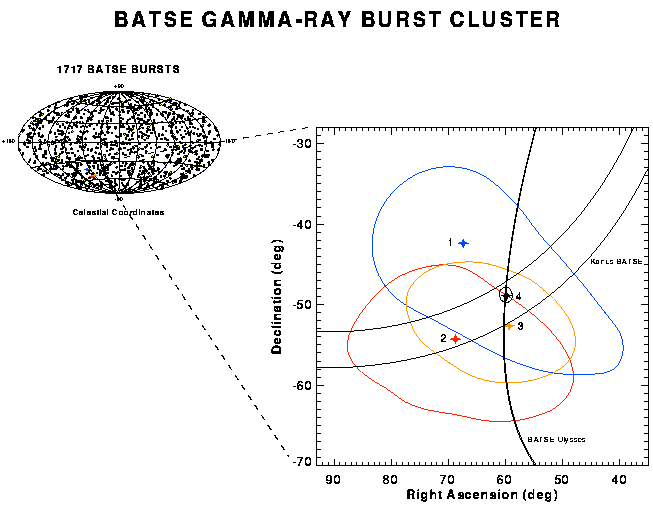Repeating Gamma-ray Source
Dec 10, 1996
Click image for larger view
GAMMA-RAY BURSTS
C. Meegan, V. Connaughton, G. Fishman (NASA/MSFC), R. M. Kippen (UAH), C. Kouveliotou (USRA), K. Hurley (UC Berkeley), T. Cline, D. Palmer, S. Barthelmy, P. Butterworth, B. Teegarden, H. Seifert, J. in 't Zand (NASA/GSFC), E. Mazets, S. Golenetskii (IOFFE) report:Several spacecraft have detected a sequence of gamma-ray bursts over a two day period whose locations are consistent with a single source. The following table gives the times of the events, the BATSE determined location with its statistical uncertainty, an approximate duration, and the spacecraft that detected the event.
| Date | Time | BATSE | ULYSSES | WIND | |||||
|---|---|---|---|---|---|---|---|---|---|
| (UT sec) | RA | DEC | ERR | DIST | DUR | TGRS | KONUS | ||
| (degrees) | (sigma) | (sec) | |||||||
| 961027 | 42247 | 67.4 | -42.4 | 5.6 | 1.4 | 100 | no | no | no |
| 961027 | 43322 | 68.7 | -54.3 | 5.8 | 3.0 | 0.9 | no | no | yes |
| 961029 | 23677 | 59.4 | -52.6 | 4.6 | 1.0 | 30 | no | no | yes |
| 961029 | 24350 | 59.8 | -48.9 | 0.3 | 750 | yes | yes | yes | |
The DIST column shows the proximity (where sigma is the quadrature sum of the statistical errors and does not include BATSE's ~1.6 deg systematic error) of the first three BATSE event locations to the fourth which has the best determined position, including Interplanetary (IPN) locations using BATSE, Ulysses and Konus. The Ulysses-BATSE IPN annulus is described by a center at RA=356.657 and DEC=-31.408 (J2000) with a radius of 49.883 deg, full width 0.078 deg. The much wider Ulysses-Konus annulus defines the end-points of the Ulysses-BATSE annular segment at RA=59.73, DEC=-47.07 and RA=60.32, DEC=-52.58 with a 99.7% confidence level. A soft gamma repeater (SGR) can be excluded as a common source by the durations of the events, as well as by their spectra, which are consistent with classical gamma-ray bursts. The temporal structures of the events are quite different, apparently ruling out a gravitational lens interpretation. The third and fourth events are very probably separate triggers from a single burst, making the combined event the longest burst (1420 sec) ever seen in this energy range. Although a posteriori calculations are problematic, the probability of such a temporal and spatial coincidence of four unrelated events is low.
If you have a question about CGRO, please contact us via the Feedback form.

